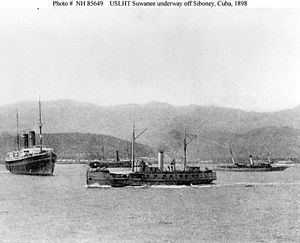Name USLHT Mayflower Operator U.S. Lighthouse Board Commissioned November 1897 Length 50 m | Namesake Mayflower Cost USD $74,872 Launched 1897 Range 1.852 million m | |
 | ||
Builder Bath Iron Works, Bath, Maine | ||
The second USS Suwannee and third USS Mayflower was a United States Lighthouse Board, and later United States Lighthouse Service, lighthouse tender loaned to the United States Navy in 1898 for service as an auxiliary cruiser during the Spanish–American War and from 1917 to 1919 for service as a patrol vessel during World War I. She also served the Lighthouse Board and in the Lighthouse Service as USLHT Mayflower from 1897 to 1898, from 1898 to 1917, and from 1919 to 1939, and in the United States Coast Guard as the first USCGC Mayflower (WAGL-236) in 1939 and from 1940 to 1943 and as USCGC Hydrangea (WAGL-236) from 1943 to 1945.
Contents
Construction and commissioning
USLHT Mayflower was a lighthouse tender built for the U.S. Lighthouse Board in 1897 by Bath Iron Works in Bath, Maine. The Lighthouse Board commissioned her in November 1897.
Spanish–American War
Just after the Spanish–American War broke out in April 1898, Mayflower was transferred to the U.S. Navy on 27 April 1898 for use as an auxiliary cruiser. She was renamed USS Suwannee to avoid confusion with the patrol yacht USS Mayflower, which also had been acquired for war service. Suwannee's war service included a brief period as the flagship of the commander of the naval base at Key West, Florida, Commodore George C. Remey. The United States Department of the Navy cited her for "conspicuous service" during the war. The war ended in August 1898, and she was returned to the Lighthouse Service in December 1898.
1899–1917
The Lighthouse Board rechristened the ship USLHT Mayflower and placed her in service as a tender maintaining aids to navigation in the 2nd Lighthouse District, based at Boston, Massachusetts. The Lighthouse Service replaced the Lighthouse Board in 1910.
World War I
After the United States entered World War I in April 1917, Mayflower again was transferred to the Navy and was commissioned on 10 May 1917 for use as a patrol vessel. She patrolled the Atlantic Ocean off the United States East Coast during the war. After the war ended in November 1918, she was returned to the Lighthouse Service by executive order on 1 July 1919.
1919–1939
After returning the Lighthouse Service, Mayflower again operated in the 2nd Lighthouse District. In 1924, she transferred to the 5th Lighthouse District. On 1 July 1939 the Lighthouse Service merged into the United States Coast Guard, and in December 1939 Mayflower was decommissioned and transferred to the Maritime Training Service in Boston, Massachusetts.
World War II
When World War II in Europe created a pressing need for tenders, the Coast Guard recommissioned the ship in July 1940 as USCGC Mayflower (WAGL-236) and based her at Norfolk, Virginia. The Coast Guard, which operated under the control of the U.S. Navy during World War II, renamed her Hydrangea on 15 August 1943 to again avoid a naming conflict with the same USS Mayflower (PY-1), which had returned to Navy service once again as a patrol craft.
Final disposition
Hydrangea was decommissioned on 8 October 1945 and transferred to the Maritime Commission for disposal. She was later sold. She is one of the very few ships to have seen service in the Spanish–American War as well as both world wars.
